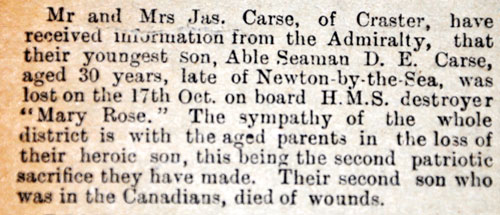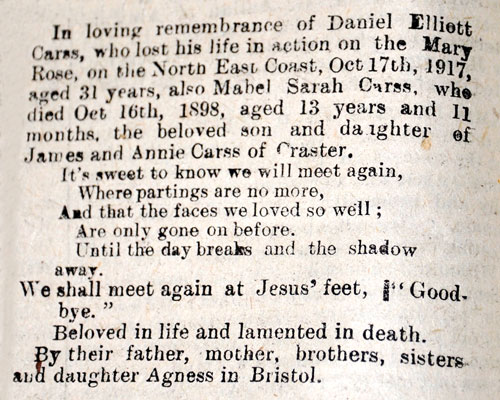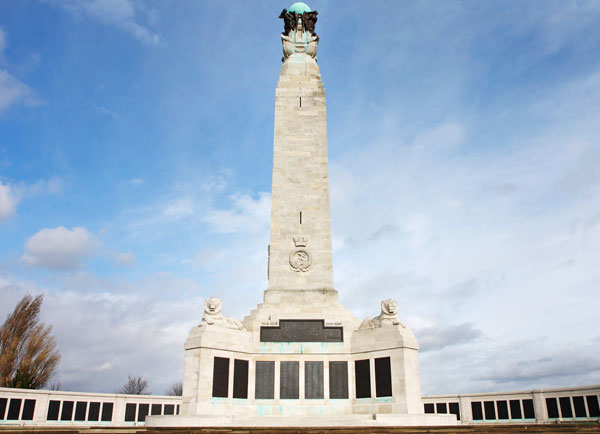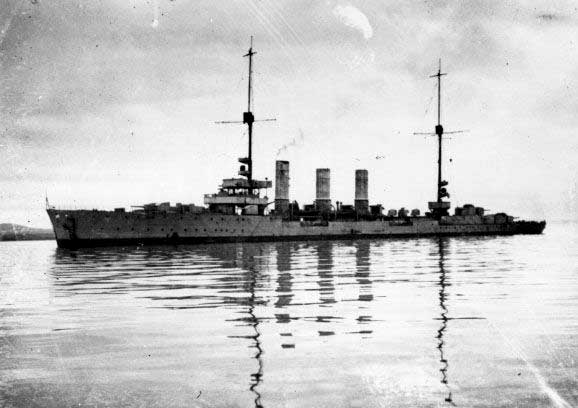 |
CRASTER WAR MEMORIALS World War Two About the Project |
Daniel CarssAble Seaman Daniel Elliott Carss, of the Royal Naval Volunteer Reserve, Service No. Tyneside Z/9276 was lost, aged 30, when serving as a stoker on H.M.S Mary Rose, which was sunk on October 17th 1917. Daniel is remembered on the Chatham Naval Memorial. He was the son of James and Annie Carss whose address on the Commonwealth War Graves web site was given as 22, The Square, Craster. At the time of the 1901 census the family were living in Newton by the Sea, where the children were born; Elizabeth, in 1878, William 1880, Joseph, 1883 and Daniel 1888. At the time of the 1911 census they were to be found at 53, Victoria Terrace, Bedlington Quarry, Bedlington. His father was a fisherman who, aged 72, was retired by 1911. Living in a four roomed house all three boys were still living at home, but daughter Elizabeth was not. His brothers Joseph and William also fought in the war, the latter being killed. In 1901 the census returns shows that Daniel, aged 13, was a 'stonebreaker' in a quarry. In 1911 he was a coal miner, working underground. At that time, aged 22, he was still single. The Alnwick and County Gazette carried the following item on November 3rd 1917:
On January 19th, 1918 the same paper carried the following announcement:
On October 19th 1918, the family inserted the following item in the In Memoriam section of the same newspaper:
H.M.S. Destroyer Mary RoseFinding itself short of ships at the beginning of the war, the Admiralty initiated a programme of ship building. In 1914, the Admiralty ordered 20 destroyers. Of these, 16 were Admiralty Design destroyers classified as M Class Emergency War Program, First Order, Admiralty Design. HMS Mary Rose was one of the 16 ships in this order. A photograph of the Mary Rose has not been found, the following image is of H.M.S. Pylades, a ship of the same class as H.M.S Mary Rose:
She was sunk by SMS Brummer and SMS Bremse, sister ships built as mine laying light cruisers. On 17 October 1917, the two ships raided along the Norwegian coast. The British destroyers HMS Mary Rose and HMS Strongbow, escorting a convoy from Norway, were attacked and sunk by gunfire, along with nine of the twelve ships in the convoy.
The British ships were out-gunned by the much bigger German cruisers. The Mary Rose was 1,250 tons fully laden and the Brummer almost 6,000 tons. Mary Rose was equipped with 4" guns and the Brummer 5.9". The German ships could strike the British ships before the destroyers guns were in range. The convoy was some 65 miles east of Lerwick heading west when the disaster happened. Mary Rose was some five or 6 miles in front of the convoy and Strongbow just to the rear. Strongbow sighted the cruisers first, initially mistaking them for British vessels. By the time she realised the true situation it was too late; she came under fire, was disabled and sunk later. The cruisers then engaged the convoy before the Mary Rose could enter the fray. Steaming back to the action, the Mary Rose was quickly sunk by overwhelming fire power from the cruisers. Very few of the crew of 88 survived. Commonwealth War Graves Commission - Daniel Elliott Carss The Great World War 1 Document Archive The loss of HMS Mary Rose and Strongbow. |
Home Programme Membership Archive War Memorials History Walk Miscellanea Links Contact Us





